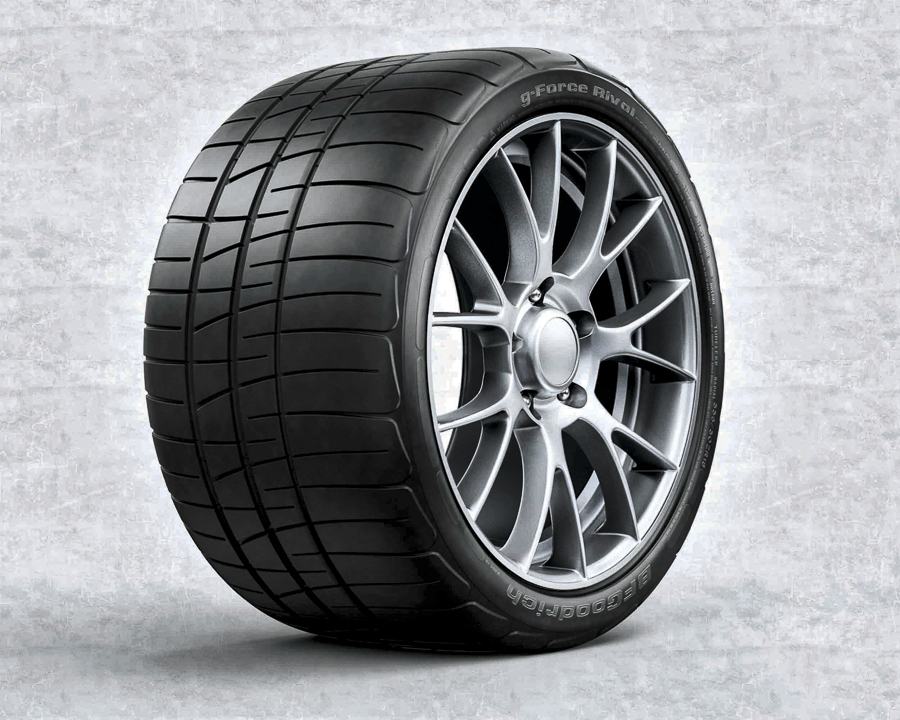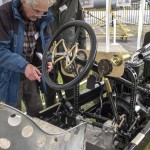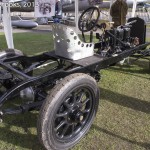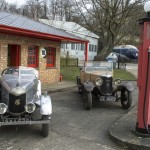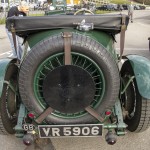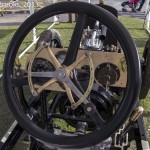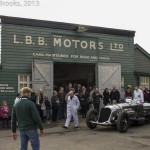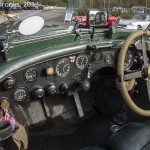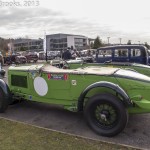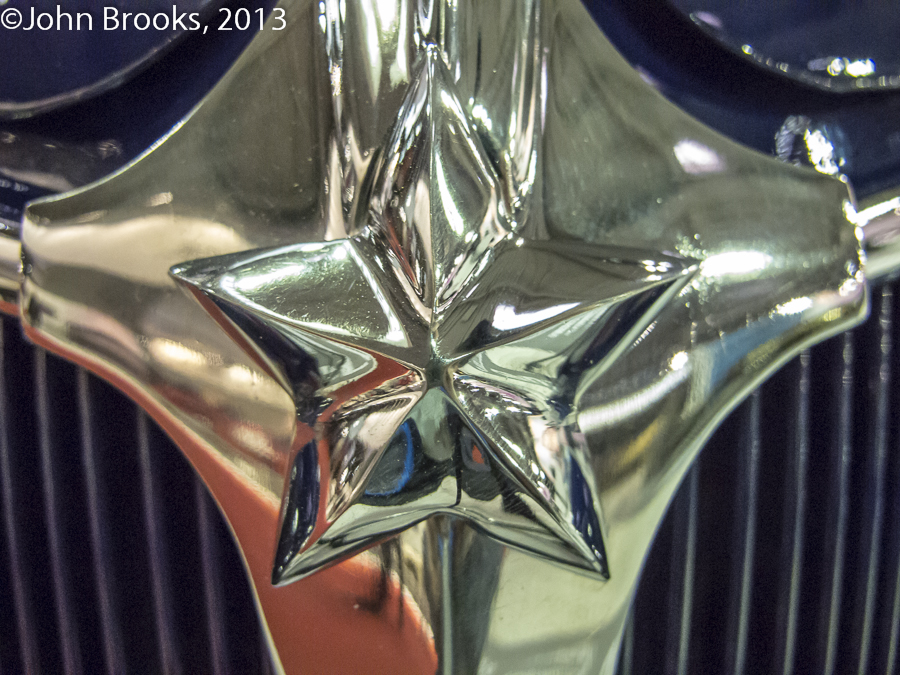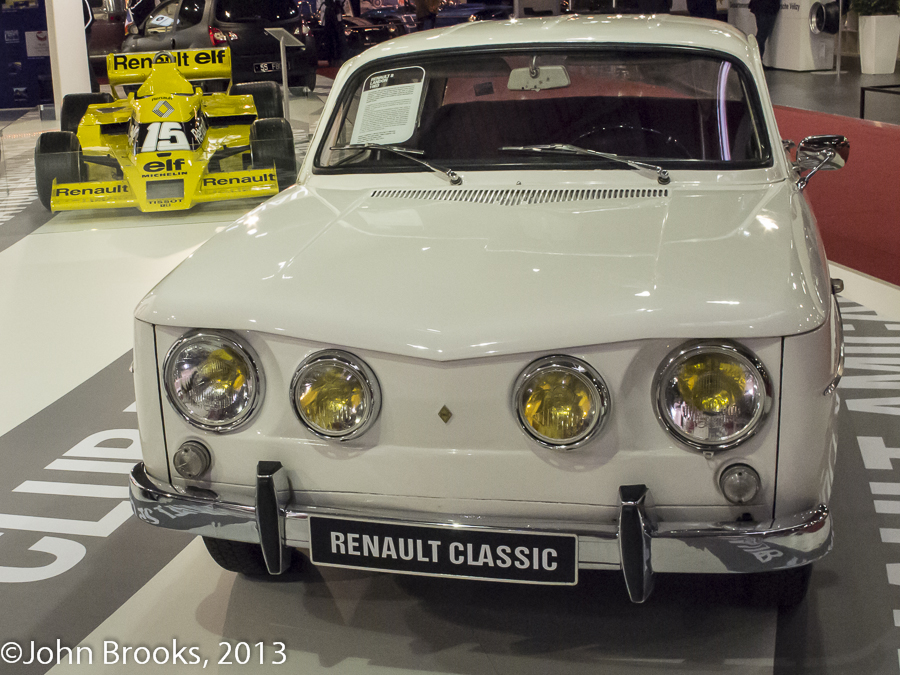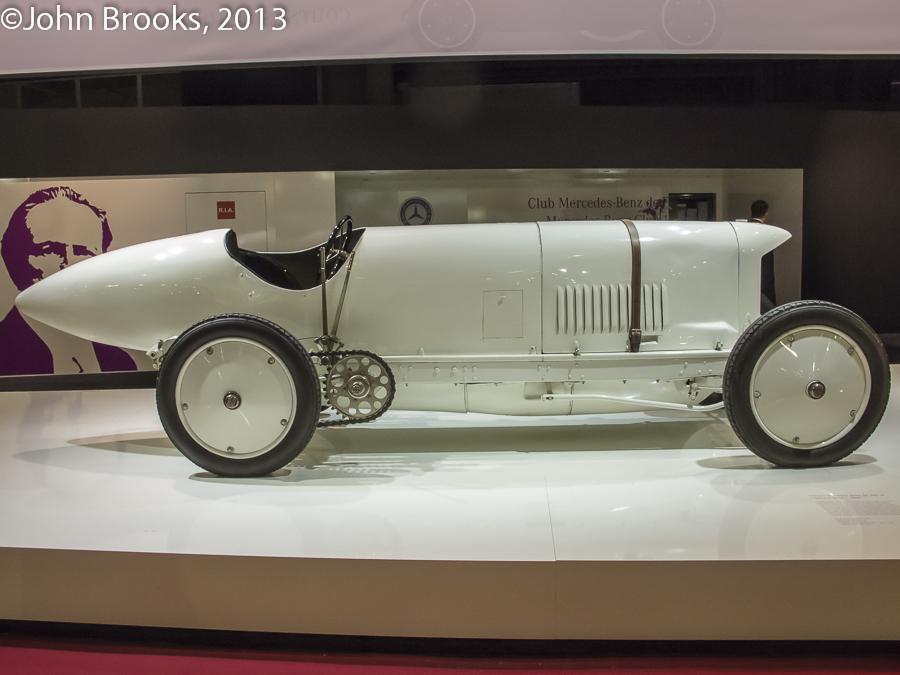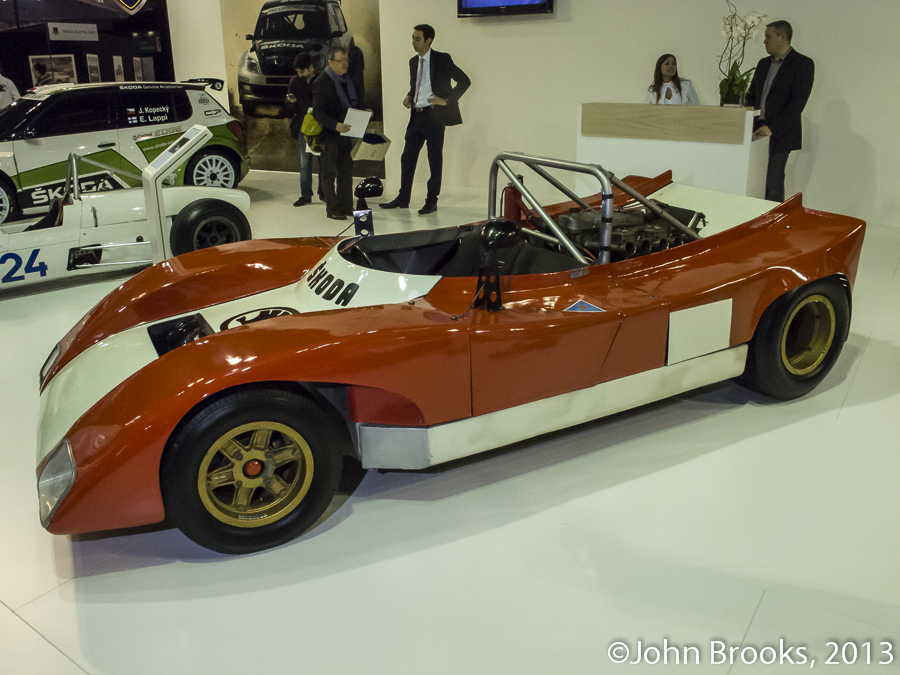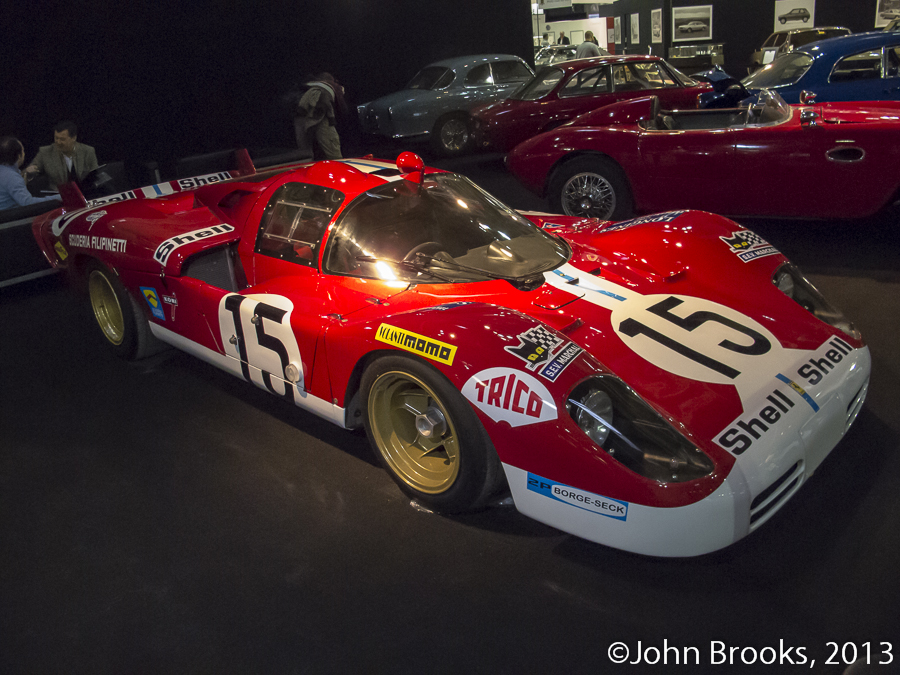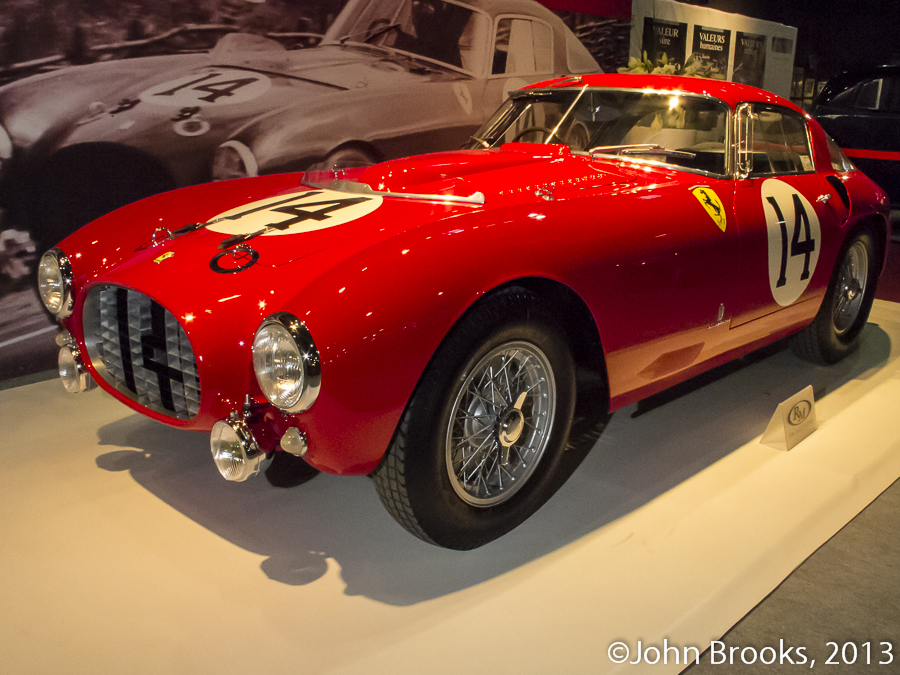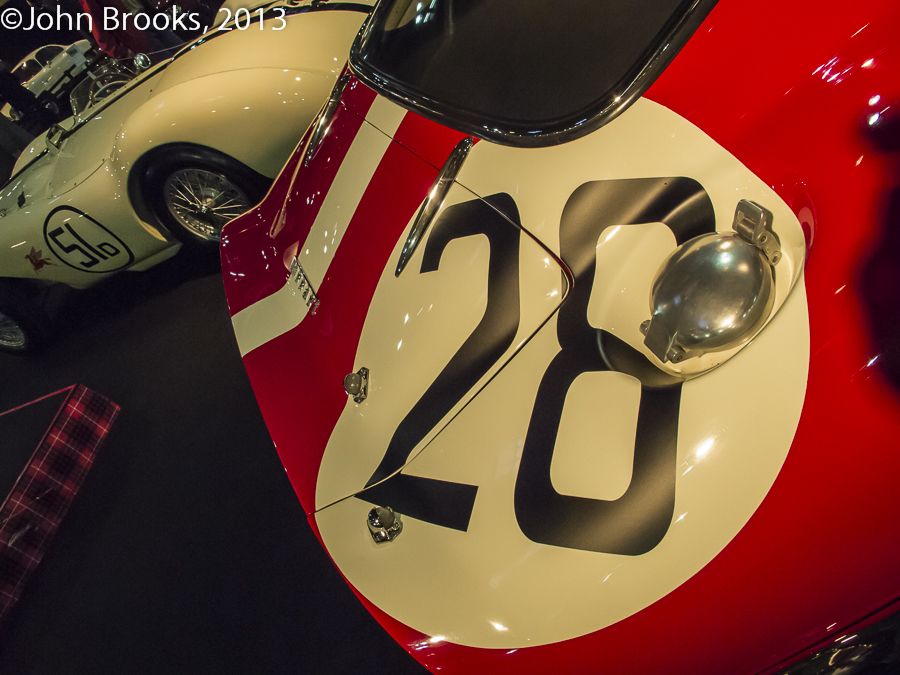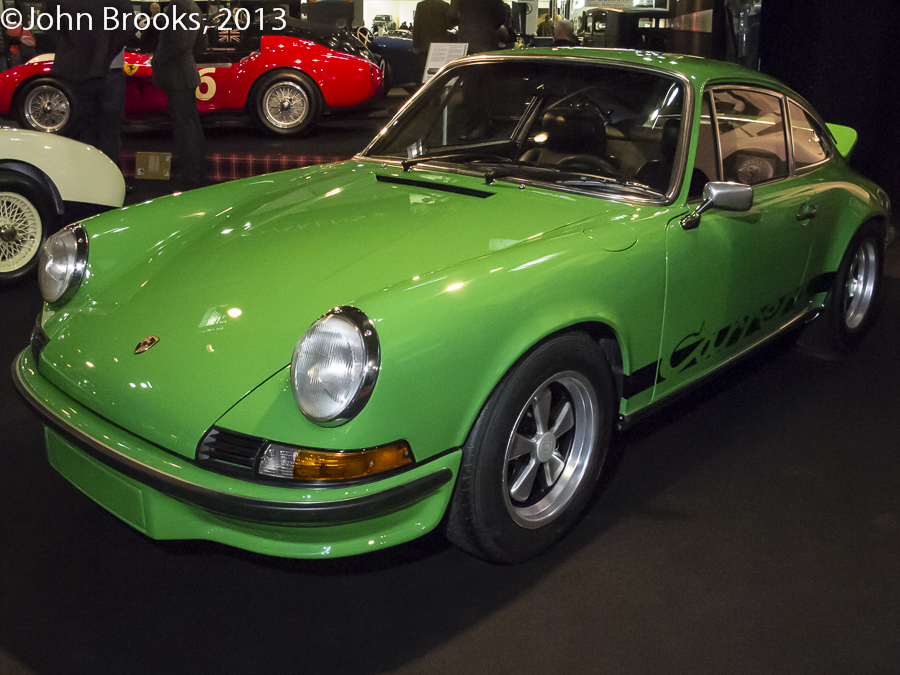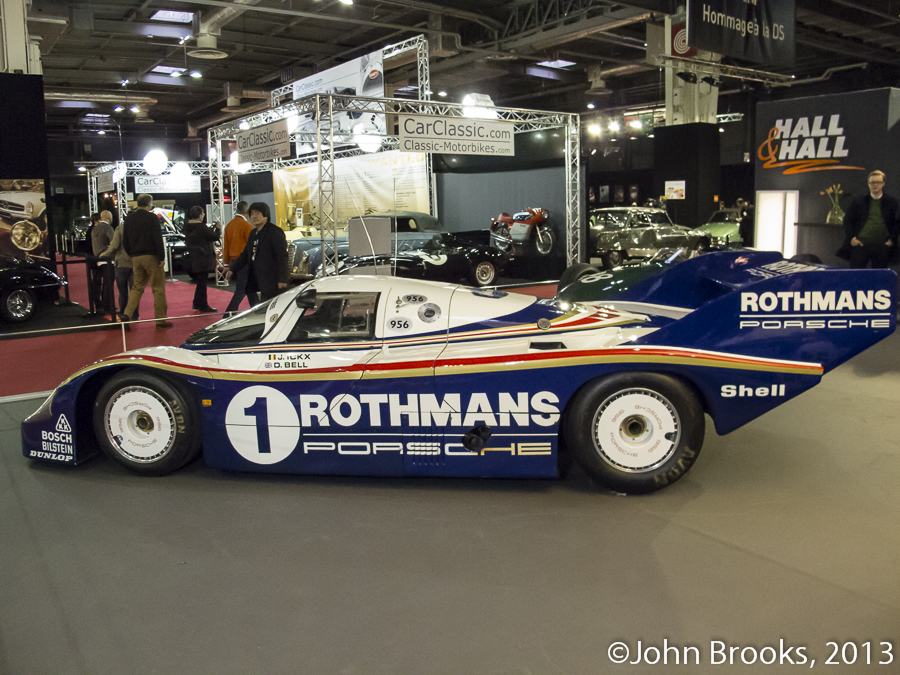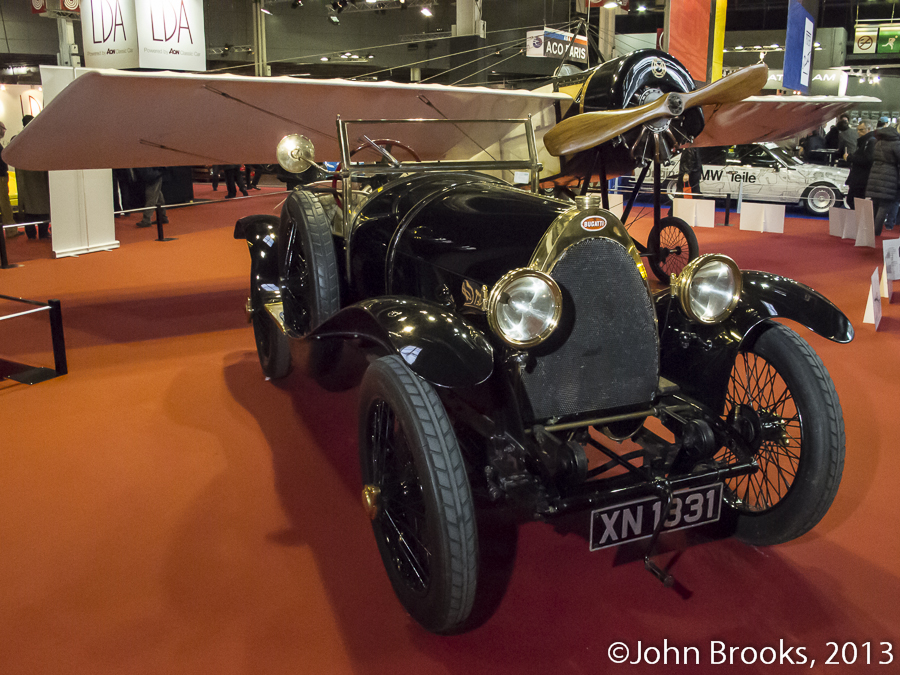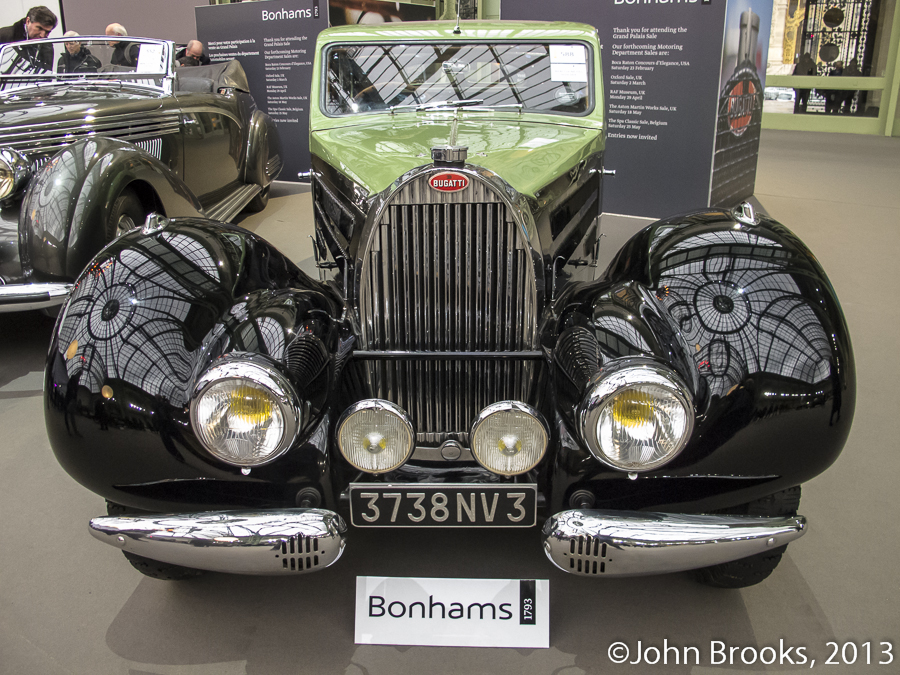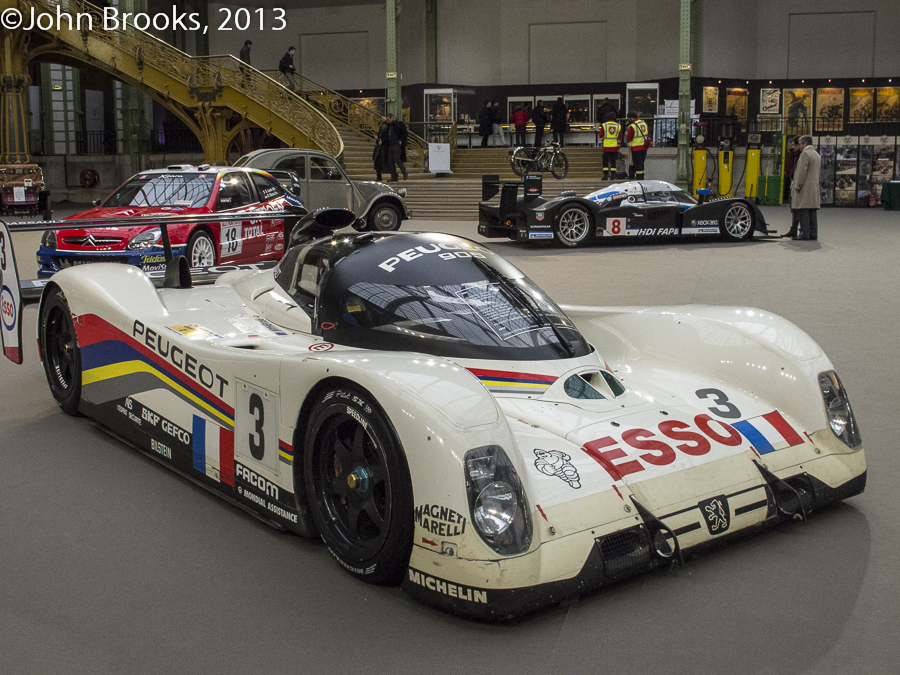Monthly Archives: February 2013
A Talbot Celebration
The Special Correspondent has been out and about again, this time to the historic venue of Brooklands. A celebration of Percy Lambert completing 103 miles in an hour, exactly a century ago, was the occasion. This prompted him to examine some of the rare and interesting cars that the members of the Sunbeam Talbot Darracq Register brought along for our pleasure.
The Barlby Road Factory
On Saturday 16 February 2013 a selection of pre-war Talbot cars gathered together at Brooklands to celebrate the achievement of Percy Lambert who, driving a special streamlined single-seater Talbot at the Surrey track exactly one hundred years ago, became the first man to drive 100 miles in one hour.
The car was based on the production 25/50 Tourer which had been re-worked by the highly-regarded G.W.A. Brown since he joined Talbot as chief engineer in 1911. He equipped the record car with bodywork similar to his design for the Austin “Pearley 3”, complete with cowled-in radiator. For the record attempt faired-in dumb irons and discs over the rear wheels were also used. The car had a 4.5-litre 4-cylinder L-head engine which gave 120 b.h.p. at 3,200 r.p.m., far removed from the 55 b.h.p. of the standard touring car. Weight was 22.5 cwt and the tyres, which stood up to the full distance, were Palmer Cords.
Lambert himself drove the car from Talbot’s Barlby Road factory in north Kensington via Kingston-upon-Thames and Cobham’s Fairmile straight to the Brooklands track for the attempt.
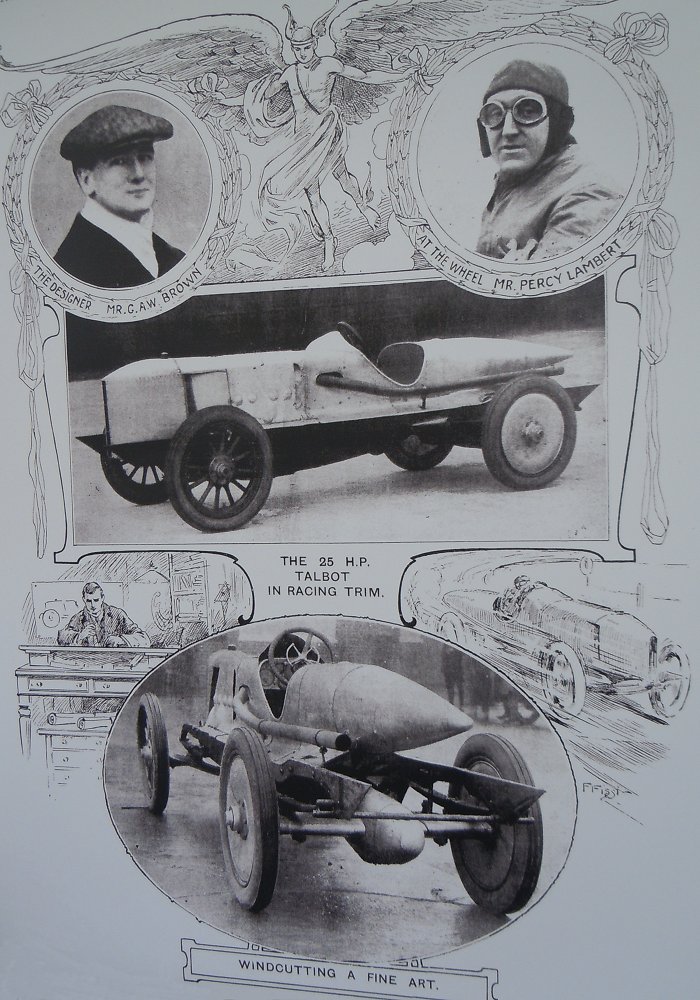
Not long after Lambert’s success Jules Goux broke the Talbot’s record of 103.84 m.p.h. in the hour driving a 7.5-litre Peugeot. Lambert wanted to have one more attempt to try and win back his record and returned to Brooklands in the October but his efforts this time ended in tragedy. On his 21st lap as he rounded the Members’ Banking a tyre seemed to let go (there was only one witness), the car careered out of control and crashed, killing poor Lambert. But nothing could change the fact that he had been the first to put 100 miles into the hour!
Below are some of the Talbots that turned up for the occasion:
First, Ian Polson’s half-finished replica of the Lambert car – the original was destroyed in the crash.
Notice in the second picture the unusual third radius arm mounted to the right of the differential:
This is a 1913 Talbot 15 h.p. Works Trials car;

These are little Talbot 8/18s, dating from 1922 and 1923 respectively. They had an o.h.v. engine designed by Louis Coatalen in the French Talbot factory in Suresnes in Paris, all very confusing!
1924 Talbot DC. This was the only Talbot present that day that was built in the Suresnes factory in Paris
A 1934 Talbot 75. This had the 2,276 c.c. version of Roesch’s superb 6-cylinder push-rod engine. The model started life as the 70 but after just 119 had been built it became the 75 to reflect its top speed.

1936 Talbot 105 Airline. The “fast-back” styling at the rear became very popular in the Thirties (in the Art Deco fashion) and was to be found on several British cars – M.G., SS(Jaguar), Rover, Riley etc. The 105 had a 3-litre engine.

1933 Talbot 105 BGH 23. This car started as one of the successful 1934 Alpine Rally Team cars, winning a Coupe des Alpes. It has a long history of competitions and in 1936 was fitted with the 3.3-litre engine of the 110 model. Driven by Mike Couper it finished its racing career in 1938, having become the fastest 4-seater on the outer circuit at Brooklands at a speed of 129.7 m.p.h., a record that cannot be broken!

1926 Sunbeam 3-litre. In 1919 the Talbot company was taken over by the Darracq firm which was British owned but based in Paris! Shortly after, Darracq bought Sunbeams of Wolverhampton and commercial vehicle makers W&G du Cros of London and the combined concern became the Sunbeam-Talbot-Darracq Group. When Sunbeam introduced their 3-litre sports car, the twin overhead camshaft engines were built in the Talbot factory in Barlby Road.

The twin cam Sunbeam engine. So much money was spent on this that there was none left to create a short chassis for the car which had to make do with the frame of an existing touring car which was both too long and not strong enough – no wonder that the chassis cracked while being driven down to Le Mans in 1925!
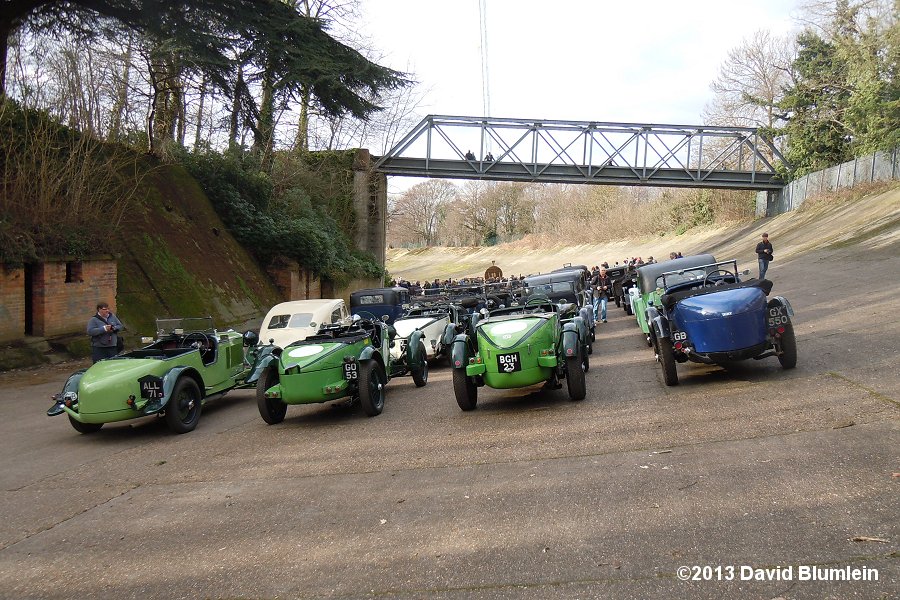
The event concluded with all the visiting cars lining up on the Members’ Banking. Here they are in the shadow of the Members’ Bridge with Roesch Talbots bringing up the rear.

A fitting final touch was the Lambert replica coming onto the banking with club members displaying numbers indicating the speed achieved just as was done a hundred years ago.
David Blumlein, February 2013
On The Skids In New Orleans
Today we welcome a new name to the DDC family, far more elegant than the usual correspondents we have but that’s not much of a compliment when I look in the mirror. Lizett Bond has been the acceptable face of the automotive media for ages, recently she went tire testing at the invitation of BF Goodrich and she kindly shares her experiences with us. I sincerely hope that she will become a regular contributor to this site, welcome Liz!
Tire testing. I’ve observed it, even written about it. But when the invite arrived in my inbox to actually participate in the BFGoodrich media launch of a new tire, taking place in New Orleans? To say I approached this one with a mix of trepidation and excitement is understatement. I was filled with a sudden urge of uncertainty. Turns out, I didn’t need to be.
BF Goodrich knows their stuff. The Charlotte, North Carolina, based tire company also understands how to extend some good old Southern hospitality and the recent media launch of the g-Force Rival in the Big Easy led to the pleasant discovery that BFG is just as savvy when it comes to passing a good time and throwing in a little lagniappe.
The g-Force Rival Extreme Performance Summer tire, the newest offering from the tire maker, demonstrates a continual quest to improve and add to the brand. This latest addition, the Rival, is a sort of hybrid, falling in between the street oriented g-Force Comp-2 and the g-Force R1, a serious, DOT (Department of Transportation) approved, competition racing tire. The Rival is eligible for those racing series requiring UTQG (Uniform Tire Quality Grading) ratings of 140 or higher, while still suitable for street use. Meaning weekend enthusiasts can drive to the track, race and head home with their trophy, all on the same rubber. In theory at least, perhaps not in practicality as it always looks more professional to bolt on a hot set of tires at a venue.
So, what more appropriate venue to debut a tire with this pedigree than a new racetrack? The NOLA Motorsport Park is located in Avondale, Louisiana, just 20 minutes from downtown New Orleans French Quarter. The public friendly track opened in 2011 as a full-featured events facility that includes two international standard racetracks, an eight-acre autocross pad and a world class kart facility.
On the track, it is a given that tires play an integral role in performance and offer a significant impact on lap times. While many enthusiasts consider braking, power upgrades or suspension to be the more crucial upgrade improvements when it comes to enhancing a car’s overall performance, the ‘shoes’ worn must factor into the competitive equation. In any segment of this market, a new tire has to transcend “good enough” and outshine competitors and the Rival g-Force was developed as a “two-fer”, with the ability to turn heads on the street and lower lap times at the track with its extreme grip.
Before heading out to the track, these talking points were relayed to us, the “legal info” according to the manufacturer, as follows:
The Rival is designed for predictability, track level abuse and highlight features, according to the manufacturer, include:
BF Goodrich’s Performance Racing Core with a reinforced internal structure reduces sidewall flex for instant steering response.
The tire is designed to stick and the Asymmetric tread with large, solid tread blocks on the outside shoulder to optimize cornering grip.
Extreme Tread Edge (ETE) raises the limit as the design brings tread compound farther down the shoulder for increased grip in hard cornering and predictable feedback.
The Equal Tension Containment System (ETCS) ensures optimum contact patch shape at speed. Silica-infused competition compound delivers better grip from start to finish.
The Rival will initially launch in 15 sizes with rim dimensions from 15-20 inches and 205-355 section width.
Laissez les bon temps roulet!
Technically correct, classroom talking points aside, we were in New Orleans to run a comparison test that included a little “fais do do” with a mix of courses, vehicles and tires.
Shuttling into the NOLA complex, an impressive line up of chariots awaited outside of the media center. Inside, sustenance, including the requisite beignets, insured high energy for a long day. After a short orientation, including a PowerPoint with plenty of tech/spec tire information, drivers were divided into groups and we fanned out to four different driving stations, each with its own task. I was nervous, having never really done any serious track driving and not being much of a speed demon to begin with. I can, however, drive a manual transmission, my saving grace.
First up for our group, the Long Course Autocross, where we would be driving BMWE46 M3’s, some equipped with Hankook Ventus R-S3 for comparison to those sporting the Rivals. My nerves calmed a bit when I realized I’d have an instructor riding shotgun.
Focusing so intently on the course, I worried that I would not be able to tell the difference between the two tires. But I could. The first attempt around the course consisted of two laps on the Rivals, then two on the Hankook and back to the Rivals. By round three, the familiarity with the course allowed for a little more attention to contrasts. The Hankooks felt softer in the turn with a slower response time, not as tight in the corners as the Rival. Even with my lack of experience, I could tell the difference and felt the Rival won, hands down. Feeling a bit cockier after my final lap, I climbed in the passenger seat for a couple of true hot laps with an instructor and humbled down a peg or two. It was also with great relief that I discovered the basket of peppermints strategically placed nearby. Pockets full of mints and great envy for constitutions that do not succumb to motion sickness, I was ready for our next station.
In spite of a little queasiness, I was gaining confidence and ready to take on the next task as I crawled behind the wheel of a Mustang FR500 racer for a few hot (or in my case “warm”) laps on the full NOLA circuit. For comparison, half of the Mustangs wore g-Force Rivals with Falken RT-614K’s installed on the other half. We completed two hot laps on the Rivals followed by two on the Falkens and then back to the Rivals. Being a ‘newbie’ to this type of track time, I certainly didn’t even approach the limits, but I could feel the difference between the two tires, with the Rival holding on to the track. I just felt more confident coming into each turn, and going around corners with the Rivals, they felt more stable, like I would not be leaving the track anytime soon.
Gaining familiarity with the 2.8 mile track helped as each lap instilled a little more confidence. Again, thanks to BFG for the fabulous instructors at each driving station. One of those coaches, Bill Follmer, yes, of that family, took the first lap with me, and with outward calm, placed my hand wordlessly on the steering wheel, each time I placed it by habit on the shifter. I think his real fear might have been a sudden burst of confidence on my part, and the possibility of being rocketed into the Florida Keys. He did make mention of the fact that he wasn’t sure which track we were on. But each lap came a little bit easier as the new Rival BFG’s inspired confidence that I would be staying on the NOLA track. Could I feel the difference? Absolutely, I felt I could push to my own limited limits with an unexpected assurance.
Time for a peppermint snack.
After a break for lunch, and a little fresh air to calm the stomach it was time for phase three…..
Next up, the Autocross featured Subaru WRX STI’s that bore no resemblance to the Subaru Outback I once owned. We were to compare the Rivals to Hankook Ventus R-S3 and Toyo Proxes R1R. We made two runs on the Rivals, and then two on the Toyo R1R and then two on the Hankook RS3, followed by a final lap on the Rival. Again, the difference in handling was noticeable, even to one with limited experience in driving an autocourse, with crisp turns that held to the line inspiring much more boldness to push to a higher limit. At the end of our runs, all three cars were lined up to compare tread wear, with the Rival distinctly showing more tread and less wear than the competition. For some drivers, this attribute may not seem essential, but as a consumer, I found this to be of great interest and crucial when considering a tire purchase.
And those weren’t jus’ flyin’ horses, cher…..
Departing the Autocross, we headed to the Skid Pad and Mazda MX5 Cup cars, all equipped with BF Goodrich examples, the g-Force Sport Comp-2, g-Force Rival and serious g-force R1-S. At this point in the day, even striped pink candy couldn’t save me and I seriously considered skipping this station. I’m glad I didn’t.
My intrepid instructor pushed me to my own limits as he measured g-force on a car mounted iPad. Our goal; To feel the “break away” point of each tire. First up, the g-Force Comp 2 tires, followed by the Rivals and finally the R-1’s. Reaching the point of hearing that coveted skidding sound, my own personal best was not depositing my peppermint on his shoes. All the tires held well, I could feel the progression with the Rival very close to the R1 in grip.
So, an A+ to BFG for patient instructors, a mix of tires and cars and for the opportunity to really compare. The Rivals inspire confidence, a huge plus being the ability to get a racer to and from the track. From a vanity perspective, I thought the tires were a more attractive design than the others. I didn’t hear anyone else discuss that, but I liked their look on a car better than the others.
And as if all that wasn’t lagniappe enough? How about a welcome party and dinner at Arnaud’s French 75 Restaurant on Bourbon Street and a soft bed in a Ritzy hotel. The well coordinated event ran smoothly, without any noticeable glitches. And the peppermints at every station were greatly appreciated.
Topping off an educational 24 hours was the opportunity to meet up in the bar during a layover in Houston’s Hobby airport, for a quick libation with several of my new driving instructor friends from the track.
Just one of the boys and better than peppermint…..
Lizett Bond, February 2013
Doing a Ton
Back in the last century when I was growing up ‘Doing the Ton’ (100 miles per hour for my American reader) was considered something a bit tasty. So last weekend at the venerable Brooklands circuit there was a gathering of enthusiasts to celebrate the centenary of the first time that one hundred miles had been completed in an hour.
The man who achieved that feat was Percy Lambert who managed to cover 103 miles in an hour on 15th February 1913. The full story can be found HERE on the Lambert family website, take time to look at the film containing original footage of the record attempt, courtesy of the Brooklands Museum.
So I took the camera along and as always at Brooklands there was plenty to see, a fantastic place.
John Brooks, February 2013
85 and Rising
It is rare that a racing driver is the subject of a press release from a major manufacturer, to have two of the giants writing about you is almost unprecedented. However perhaps in Hans Herrmann’s case it is less surprising. He hits 85 today, so Happy Birthday, Hans.
I had the pleasure of meeting Hans back in 2010 at Sebring where he triumphed in the 12 Hours some 50 years before. Somewhere in the confusion that is my office is an interview with the great man, most of the recording was drowned out by a crappy Trans-Am race that was unfolding outside so my masterpiece makes little sense, lesson one learned.
His career was an extensive one with spells at Porsche, Mercedes-Benz, Arbarth, Maserati and Borgward. His crowning achievement was winning the Le Mans 24 Hours in 1970 with Richard Attwood in a Porsche 917. He could also point to having competed at long gone events like the Mille Miglia, Targa Florio and Carrera Panamericana. It is said that you are judged by the company you keep, so you could think yourself just slightly special if among your team mates you could list Juan Manuel Fangio and Stirling Moss. I could go on and on, there were many others.
But I will have to make do with the releases from Porsche and Mercedes-Benz and some evocative photos. Once again Happy Birthday Hans.
Porsche congratulates Hans Herrmann
Stuttgart. Hans Herrmann, one of the most successful and best known works racing drivers at Dr. Ing. h.c. F. Porsche AG, will celebrate his 85th birthday on 23 February 2013. Born in Stuttgart in 1928, this long-distance specialist was considered one of the most successful and dependable racing drivers of his era. His motorsports career lasted from 1952 to 1970, during which Hans Herrmann won over 80 overall and class victories.
Hans Herrmann started his racing career in early 1952, piloting a privately-owned Porsche 356 1500 in mountain races, rallies, and endurance races. A year later he and Richard von Frankenberg took overall fifth place in the Lyon-Charbonnieres rally. Porsche racing chief Huschke von Hanstein thereupon hired him for the Porsche Works team. Herrmann drove the 550 Spyder at the 1953 24 Hours of Le Mans, and together with Helmut Glöckler came in first in the 1.5 litre displacement category right off the bat.
In 1953, at the age of 26 Herrmann won the title of German Sportscar Champion and got the attention of legendary Mercedes-Benz racing chief Alfred Neubauer, who hired him for his works team. Hans Herrmann piloted the Mercedes W 196 Silver Arrow in the premier category of motorsports, teaming with top drivers like Juan Manuel Fangio and Karl Kling. Parallel to that, in 1954 he continued to drive for Porsche in the smaller displacement categories. In the 550 Spyder he won widely noted class victories in the Mille Miglia and Carrera Panamericana.
When Daimler-Benz pulled out of racing in 1955, Herrmann went on to drive Formula 1 races for Maserati and BRM, as well as other races as a Borgward works driver. In 1957 he became European Vice “Bergmeister” – Mountan Champion – before returning to the Porsche works team in 1959. Together with Joakim Bonnier, in 1960 Herrmann took the overall victory at the Targa Florio in a Porsche 718 RS60 Spyder, and the Formula 2 championship in a Porsche 718/2. He also won the 12 Hours of Sebring with Olivier Gendebien. In 1963 he left Porsche KG and joined Carlo Abarth’s racing team.
In 1966 Herrmann returned to the Porsche works team, not only driving in all the major long-distance races and European Mountain Championship races, but also doing countless test drives in Weissach. With pilots Hans Herrmann, Jo Siffert, Vic Elford and Rolf Stommelen, in 1969 the team took the World Sports Prototype Championship for the first time. In 1970, at his eleventh Le Mans race Herrmann capped off his career with a bang, winning the first overall victory for Zuffenhausen in a Porsche 917 KH. He took this motorsports achievement as a suitable time to retire from active racing, after 42 years on the track. Since then Hans Herrmann has lived with his wife Magdalena near Stuttgart, successfully operating his company “Hans Herrmann Autotechnik.” As a pilot of historic racecars, he also takes part in many vintage car events for the Porsche Museum.
Hans Herrmann celebrates 85th birthday
Legendary racing driver Hans Herrmann celebrates his 85th birthday on 23 February 2013. Born in Stuttgart, Herrmann gained international recognition during his time as a works driver for Mercedes-Benz in the years 1954 and 1955. The cars he drove for the brand back then were the post-war “Silver Arrows”, the W 196 R Grand Prix racing car and the 300 SLR (W 196 S) racing sports car.
These days Hans Herrmann is regularly to be found behind the wheel of historical Mercedes-Benz competition vehicles, as a guest at any one of a variety of classic events, where he is able to convey to visitors the fascination of an important period in motor racing. “Our congratulations to our brand ambassador Hans Herrmann, who has been a good friend of Mercedes-Benz for almost 60 years now,” commented Michael Bock, Head of Mercedes-Benz Classic, expressing his thanks to Herrmann for his contribution to keeping the brand’s heritage alive.
The legendary Alfred Neubauer, Head of the Mercedes-Benz racing department in the 1930s and again in the 1950s, discovered Herrmann as an up-and-coming talent and brought him into the works team, alongside Juan Manuel Fangio and Karl Kling, for Mercedes-Benz’s re-entry to Grand Prix racing after the Second World War. For the 1955 season, the team was then joined by Stirling Moss.
In the very first race of the new Silver Arrows at the French Grand Prix of 1954 in Reims, Herrmann drove the fastest lap time, 2:32.9 minutes – corresponding to an average speed of 195.463 km/h. Over the course of the season he took two Grand Prix podium places, in the 1954 Swiss Grand Prix and the 1954 Avus race, in each case coming 3rd. In 1955, Herrmann was seriously injured in an accident during practice in Monaco and was no longer able to start during that season.
Even after his Grand Prix racing career with Mercedes-Benz had come to an end, “Lucky Hans”, as his friends know him, retained close links with the brand. In 1961, for example, he entered the “Gran Premio Argentina” road race in a Mercedes-Benz 220 SE (W 111), finishing in 2nd place behind Walter Schock, also in a 220 SE, to deliver a double victory.
After training originally as a pastry chef, Hans Herrmann began his career in motor racing in the Hessen Winter Rally of 1952 in a private Porsche 356. That same year he took a class win in the “Deutschlandfahrt” (Tour of Germany). In both 1953 and 1954, Herrmann then took class victory for Porsche in the legendary 1000-mile “Mille Miglia” race in Italy.
Through his participation in Formula 1 as well as Formula 2 Grand Prix races, sports car races and rallies, Stuttgart-born Herrmann proved himself to be an exceptionally versatile motor racing driver. Apart from the cars he drove for Mercedes-Benz, he competed above all in Porsche racing and sports cars. He also took the wheel at various times for B.R.M., Cooper, Maserati and Veritas.
Hermann achieved his greatest successes in sports car endurance racing. Among his wins were overall victories in the Targa Florio (1960), the 24 Hours of Daytona (1968), and the 24 Hours of Le Mans (1970). In honour of the grand total of eight Targa Florio races in which he had driven, Hans Herrmann was presented with a special award by the Sicilian town of Collesano in October 2012. “Noblesse oblige”: the one-time works driver arrived at the award ceremony in a Mercedes-Benz 300 SLR.
After capping his success in motor racing with the Le Mans victory of 1970, Herrmann withdrew from active motor racing that same year, at the height of his career. From then on he would devote himself above all to his automotive accessories business. But our “birthday boy” has retained close links with the world of motor sport to this day – above all as a brand ambassador for Mercedes-Benz Classic.
Vettes in the Wild
Sebring 2001 and a pair of Corvettes with Andy Pilgrim and Chris Kneifel are scrapping, not just with each other, but also with the Saleen of Franz Konrad, Terry Borcheller and Oliver Gavin, who hang on to take a famous victory. The Saleen is history now but the Vettes will again be on the prowl soon down the runways of Hendricks Field.
John Brooks, February 2013
Return to the Grand Palais
Our Special Correspondent visited the recent Bonhams Sale at the majestic Grand Palais, as ever he cast a keen eye over the cars assembled, here he shares some thoughts with us.
A welcome back for cars in the Grand Palais, home of the prestigious Paris “Salon de l’Automobile” from 1901 to 1961. This impressive building with its extensive glass vaulting and iron and light steel frame was constructed for the Universal Exposition in Paris in 1900 and was duly opened on 1 May that year. The Motor Show outgrew it and was re-located to the capacious exhibition halls at the Porte de Versailles but it did not take the atmosphere with it!
Well done, Bonhams, for choosing such a nostalgic setting for your auction! Here are a few of the more interesting cars put up for sale:
1916 Packard Twin Six
In May 1915 Packard made history by introducing the world’s first quantity produced V-12 engine. It was a 60 degree L-head unit of 6,950 c.c. and over 30,000 were made before production ceased in 1923. The smooth running of this engine is said to have inspired Enzo Ferrari to adopt the V-12 configuration for his own cars. And it was in a Packard Twin Six that the American President, Warren Harding , was driven to his Inauguration in 1920, the first time a president travelled by car to this important ceremony.
Here is a Packard V-12 engine.
Marion Bobcat Speedster
Speedsters and Roadsters like this were all the rage in America in the five years or so before the Great War, with the Mercer Raceabout and the Stutz Bearcat the most well-known. The Marion was one of those numerous makes that hailed from Indianapolis and, interestingly, their Chief Engineer from 1906-10 was Harry C. Stutz who would certainly have had some input in this car which is thought to date from 1911.
1921 Rolls-Royce 40/50 Silver Ghost Alpine Eagle
The 40/50 Rolls-Royce was introduced in the autumn of 1906 and soon became known as the “Silver Ghost”. It was the car that established the company’s reputation and was the only model produced from 1907 until the introduction of the “Twenty” in October 1922. This variation arises from the sporting activities of one James Radley who privately entered his Silver Ghost for the 1912 Austrian Alpine Rally and found that the car would not climb the Katschberg Pass owing to the inadequacy of its 3-speed gearbox. As can be imagined, this did not go down well back at the factory in Derby and their answer was to develop a car with more power, to fit a new 4-speed gearbox and build four special cars and enter a “works” team of three plus one for James Radley in the 1913 Austrian Alpine event. These cars did very well, winning six awards. With honour restored, the company decided to build a series of customer cars to the same specification and these were called officially the “Continental” model. However, the Chief Tester Ernest Hives, later Lord Hives, nicknamed them “Alpine Eagles” and the name has stuck ever since!
1928 Detroit Electric Model 95
Electric cars were popular in America until the late Thirties. Detroit Electric was one of the main manufacturers and it is estimated that this company produced over 35,000 such cars in the three decades of its existence, all with similar looking bodywork. Even in the earlier days of production these cars had a range of 70 miles and could reach 45 m.p.h. – oh dear, we have not come very far since!
1977 Stutz Black Hawk VI Coupé
The Stutz rose to become one of America’s most prestigious makes by the time of its demise in the mid-Thirties. Harry Stutz made his first car in time to take part in the first Indianapolis 500 race in 1911 where it finished 11th. This enabled Stutz to proclaim his slogan “The Car that made Good in a Day”, and there was a demand for replicas. Stutz cars were very involved in competitions in those early days and the company was turning out such racy production cars as the Bearcat roadster, initially with Wisconsin engines before Stutz started making their own in 1917. The Stutz name was revived in 1970 in New York and the ex-Chrysler stylist Virgil Exner penned this extravagant design. The bodies were made in Italy and the cars used GM mechanicals, this one using a Pontiac V8. Although various body styles were available, the cars were very expensive and only about 60 were produced. The above car takes its name from a famous Stutz sporting car which in 1928 very nearly beat the Bentleys at Le Mans!
1948 Tatra T.87
Hans Ledwinka was the genius behind the remarkable Tatra cars. His trademark was all independent suspension with a backbone chassis, and he presented in 1934 the stunning T.77 which had a futuristic aerodynamic body on typical Ledwinka mechanicals but with a rear-mounted air-cooled V8 engine. Initially this car had a centrally placed steering wheel, an idea copied by the Panhard Dynamic and the McLaren F1 road car, but more importantly the body gave a co-efficient of drag of only 0.21, exceptional for that time. Despite the engine giving out a mere 59 b.h.p., the T.77 could reach 87 m.p.h. Its weakness was in the handling department with all that mechanical weight concentrated at the back and Ledwinka answered this by drawing up the T.87 in 1936. This was shorter and lighter and had a 3-litre V8 which gave the car a 100 m.p.h. performance with a still impressive drag of just 0.36. The T.87 remained in production until 1950 and among its clients were Ernst Heinkel, Erwin Rommel, Felix Wankel and King Farouk of Egypt.
TAILPIECE
This is an example of the Fiat 238 van that claims a place in the company’s history because it is the first production Fiat to have front-wheel drive. The mechanics are based on those of the Autobianchi Primula car.
David Blumlein, February 2013
Retro Retro
It is safe to say that the Classic Car Season really kicks off when the Retromobile comes round.
Held at Pavilions 2 and 3 at the Parc des expositions, Porte de Versailles, Paris, the Retromobile has grown in stature and importance, as well as size, reflecting, perhaps, the general rising level of interest in automotive heritage.
The Show is a cocktail of many ingredients, from the flea market to the top dealers, car manufacturers to the car clubs, enthusiasm abounds and there is much to see for even the casual visitor, let alone the dyed in the wool enthusiast.
This Delahaye is typical of the quality that was found throughout the Retromobile.
Despite the difficult trading conditions that prevail in Europe’s car market, especially for the French, there were prominent stands from Peugeot, Citroën and Renault, the latter having a well designed circular effort with the stars being
a 1937 Renault Nerva Grand Sport
and, from 1968/69, an Alpine Renault A220 that ran at the Le Mans 24 Hours.
I also liked the contrast between the Renault 8 and Renault’s first modern day F1 car.
The 70’s graphics are still striking.
I witnessed the Renault RS01’s first race at Silverstone in 1977, the turbo era had arrived, though we did not appreciate it that day. We were more concerned with James Hunt and John Watson, and some crazy Canadian, Gilles Villeneuve making his debut.
As with every show, anniversaries and birthdays are celebrated, any excuse and the Retromobile was no exception. So 30 years of the 205, one the quintessential hot hatches, was a focus on the Peugeot stand.
Citroën’s DS19 did not have any obvious celebration to make, except being about as Gallic as is possible for a car. There were many fine examples of this ground breaker to be seen.
The Germans occupied a big slice of Parisian territory with one of the show’s highlights being the Mercedes-Benz stand.
Leading the fine selection of Mercedes rarities was a joint exhibition with the Louwman Museum of the pair of recently restored Prince Heinrich 1910 Benz. The pair of cars had left in store room for decades, and recognising the importance of these cars, the two organisations decided to pool their efforts at restoration.
“Since the beginning of the twentieth century, a large number of car races have taken place in Europe. Sons of wealthy families and rich sportsmen were the main competitors. One of these races was the Prince Heinrich, named after a keen sportsman who was the brother of Kaiser Wilhelm II. It was restricted to four-seater touring cars.”
“On 10 June 1910 no less than 10 Benz cars took part in a 1,900 kilometer race across Germany and part of France. They had 80HP and 100HP engines with lubrication pumps, drive shaft transmission replacing the old chain system, and elegant ‘tulip’ bodywork. A month later, some of these cars took part in the ‘Kaiser Nicolas’ race in Russia covering 2,800 kilometres in eight days.”
Speaking of the Louwman Museum, they had as a companion to the Benz a 1903 Spyker as they describe it. “This was the first car in the world to be equipped with a six-cylinder engine, and the first petrol-driven car with four-wheel drive and all-wheel brakes. This Spyker 60-HP is therefore one of the most significant cars in motoring history.”
Rounding off the display of Mercedes Benz’ rich heritage was the “Blitzen Benz”.
“One of the key goals in those early years of the 20th century was to break the then magic speed barrier of 200 km/h. Benz was the first company to do so, with a petrol-engine automobile: the 200 hp racing car took to the track at the Brooklands circuit in England in 1909, achieving an average speed of 202.7 km/h. This record-breaking racing car, with its massive four-cylinder engine, would however go on to achieve its greatest successes in Florida, USA. In 1911, Bob Burman reached the amazing speed of 228.1 km/h on the sand track at Daytona Beach, so making the “Lightning Benz”, as the model became known in the US, the fastest vehicle in the world – faster even than any aeroplane or train. It was a record that would remain unbeaten for eight years.”
Porsche began the first of many celebrations of the 50th anniversary of the 911 with a fine selection of examples of the model through the years. Yes I know it’s a 935…………….
BMW’s stand was frankly disappointing with some strange concept cars paying homage to the 328 and the M1, must have sounded better on paper than it looked in reality.
Bentley had a small stand with the amazing Embiricos 4¼ Litre Pourtout Coupé on display, the impact of this important car only slightly diminished by obscure location and lighting of the stand. This will be the last appearance of this Le Mans’ veteran on this side of the Atlantic for a while.
Sharing with the men from Crewe were fellow VW Group members, Bugatti, who brought out a Type 59 Grand Prix racer from 1934. I drew encouragement from the fact that it sported a tax disk, meaning that someone drives it on the UK roads.
Skoda displayed an interesting array of rarely seen competition cars dating back to the 60’s including this sports prototype, the 720.
There are always a selection of quite obscure vehicles at the top shows, tucked away in a corner was a stand celebrating Germain Lambert, an enterprising engineer who ran Automobiles Lambert from the 20’s through to 1953. This is the Lambert 6CV.
Lambert was also an enthusiast, who raced his own creations, this is the CS Cabriolet Sport
The output of another French engineer, Marcel Leyat, was also exhibited at the Show. His idea was to have a lightweight wooden chassis powered by a propeller, a plane without wings.
During the 20’s he managed to sell around 30 of these strange contraptions but the concept never really caught on.
One of the delights of shows such as the Retromobile is finding the unexpected, here I encountered the Scuderia Filipinetti Ferrari 512S as driven at Le Mans in 1970 by Mike Parkes and Herbert Müller. They were eliminated in the notorious accident early in the race that took out the three 512s of Regazzoni and Wisell, as well as Parkes, I am sure it made for an interesting debrief.
Another 70’s Ferrari present was this immaculate 512 BB LM
And Paul Knapfield’s 312PB, with extra air intake to cool the F1 spec engine.
And one last Prancing Horse, from the early days, a Ferrari 340/375 MM Berlinetta Competizione, promoting the Villa d’Este Concours.
Carrozzeria Touring Superleggera had a stand to show off their skills and it contained a rarity from Lamborghini, dating back to 1966, the Flying Star II prototype. This was a collaboration with the factory and based on a Lamborghini chassis.
The Retromobile had a wide range of automobilia for sale, from the likes of Hortons Books to several stands offering fine wines, and of course there are the ART stalls.
Steve McQueen still has a power to fascinate……………..
Someone’s wall is incomplete without this
The Lukas Huni stand had several outstanding cars, the pick of which was this Type 57 Bugatti
And this Alfa Romeo 8C 2300 Monza
I might be a bit biased but to my mind the two stands that were head and shoulders above the others came from across the English Channel.
The sheer quality of the cars on Hall & Hall and Fiskens, or Fiskens and Hall & Hall, depending on whose stand you were on, was staggering.
Highlights at Fiskens were two Le Mans’ veterans, the 1926 Bentley 3L Le Mans and Scuderia Filipinetti Ferrari 275 GTB/C that was a class winner in 1967, these endurance classics were just part of a fantastic set of cars that the well known London based dealer had in Paris.
I caught up with Gregor Fisken who gave his thoughts on the 2013 Retromobile.
“Every year it gets a little bit bigger, a little bit better, I think the show has really found the right balance. It is important that it still has elements of a flea market, it is important that the modern manufacturers can come in and embrace their heritage as well. It is important that there is wonderful art, models, parts but it is also important that it is Europe’s pre-eminent début event of the year. It kicks off the year and everyone leaves here motivated, they see old friends, they make new friends, they plan for the season and they have the opportunity to review what they are going to use in the future.”
“What we have here on the stand today, I think, is a little bit of something for everyone. We have arguably one of the most important Le Mans’ Bentley team cars to come on the market in recent years and we have a Bugatti T37A that has had 50 years of one family ownership, so that is a special opportunity. Of course with the Ferrari 275 GTB/C there is an opportunity to purchase a car that raced in Les Vingt-Quatre Heures du Mans three times and it won its class. We had Claude Sage on the stand, from Scuderia Filipinetti, who ran the car in period. He remembered driving the car from Geneva to Le Mans, the car running in the race and then being driven back afterwards, absolutely fantastic.”
“I think cars from this period, the 60’s GT era, were the last that could be genuinely driven from the factory to Le Mans, win their class and be driven home. I think for a lot of new people that are coming into the market they find the opportunity to use such a car on the road and on rallies, events and races is very attractive. They can go to the Le Mans Classic and have a pretty prestigious way to travel down the Mulsanne.”
It is hard to imagine but this impressive array of classics were matched by the Hall & Hall display. Endurance Racing was again well represented with Porsche 956/001 supporting Jaguar XJR-12 chassis 288, with the unique record of a victory in both the Le Mans and Daytona 24 Hours. Another flash from my misspent youth was a Lotus 49C in Gold Leaf Team Lotus livery, this being an unraced spare built for Ford.
Rob Hall gave me his views on the Retromobile. “We have been attending the Retromobile for seven years now, it starts the season off for us really, it is a good shop window for the selling side of the business, a few of the cars here are not for sale but they add to interest to the exhibit and it gets our name noticed. It costs us certainly but during the rest of the year we recoup the outlay, either through picking up work or picking up sales.”
“I had a quick look round the Show early today before things got busy and it is clearly a great event. There is something for everyone, whether it is old, new or something to help you work on your car.”
“The Show is quite a big commitment but what has made it a lot easier is that it is now condensed into one weekend and a few days as opposed running over two weekends as it did in the past. The cost of hotels and travel and having staff on site has been reduced and that acts as an incentive for us to come to Paris. So both parties benefit.”
A show would not be a show without an auction taking place and Artcurial provided the necessary ingredients, with many fine lots. The hammer came down the loudest when a 1936 Talbot Lago T150C Roadster went to a new owner for just under €1,500,000, despite the financial storms that rage in Europe there is still some money about for a classic car.
The 2013 season is now underway having been launched at the Retromobile, it is worth a visit and especially as Paris is but a short train ride away, it can be done in a day and enthusiasts should be making their plans for February 2014.
John Brooks, February 2013
Un Siècle de Génie Automobile Français au Grand Palais
Bonhams recent sale in Paris was also the scene of a tribute to ‘A Century of French Automobile Genius’. Held in the majestic location of the Grand Palais, just off the Champs Elysees, the auction house, with support from Peugeot and Citroën, assembled a collection of around 30 cars that illustrated the major contribution that the French have made to the development of the automobile.
The setting of the Grand Palais for such an exhibition is of course extremely apposite, given that this was the site of the Paris Salon which was held there for many years until the show outgrew the hall.
As with any collection of fine automobiles they are all equal, but inevitably some are more equal than others and while I recognise the quality of the very early cars, some dating back to the 19th Century, my own preferences are more modern. Star of the show as far I could see was the two tone Bugatti Type 57 C Coupé Special dating back to 1938.
About as original as is possible, right down to the wiring loom and electrical components, the car was used by Ettore Bugatti and Jean-Pierre Wimille prior to World War Two. After the Fall of France, Grand Prix ace and Le Mans winner for Bugatti, Robert Benoist, prudently hid the vehicle to ensure its safety. Benoist, recruited into the SOE to organise and support the Resistance, did not survive himself, being captured twice by the Gestapo, eventually he was murdered at Buchenwald in 1944.
The Type 57 was returned to Bugatti at the end of hostilities and it was subsequently used as a test bed for new ideas and components which explains the Lockheed Hydraulic brakes. It was, and is, utterly beautiful and desirable, well we can all dream.
From the lofty expression of automotive art that is the Bugatti, I was drawn to the familiar functional shape of the Peugeot 905, this example being the actual car that Geoff Brabham, Eric Hélary and Christophe Bouchut drove to victory in the 1993 Le Mans 24 Hours. The Peugeots swept all before them in that last gasp of the Group C era.
With power in abundance from a 3.5 litre V10 engine and staggering amounts of downforce these were some of the fastest race cars ever built, at Silverstone in 1992 the Peugeot would have qualified on the second row of the British Grand Prix, and this from a car designed to race for 24 hours.
It was interesting to compare this thinly disguised Grand Prix car with the Peugeot 908 HDi FAP, a diesel powered endurance racer that, in 2009, routed the much vaunted Audi Sport team. This example was the second placed car at Le Mans that year, narrowly beaten by their sister car.
Much more in touch with the real world was the Citroën 2CV, introduced to an expectant public in 1948 who were clamouring for simple, inexpensive solutions to their motoring needs. With nearly four million examples made in the following decade, this quirky looking car came to symbolise the French automobile industry.
Another Citroën with a record of success is the World Rally Championship Xsara WRC which racked up win after win in the hands of Sebastian Loeb, cementing the French manufacturer’s domination of top flight rallying in this century.
Back to the time when the French car industry seemed to be an offshoot of the Louvre, so elegant were the designs, is the Delage D8 Torpédo, built in 1931. The Delage factory at Courbevoie was the most modern of its time and its produce was snapped up by celebrities and Royalty alike, the looks have weathered the test of time.
From the early days of motoring, the De Dion Tricycle and the Peugeot Type 17 illustrate the birth of the French motor industry. Other absolute classics on hand were a Bugatti Type 54 Grand Prix car, a Talbot Lago T26 Cabriolet and two more icons from Citroën, a 1953 Traction Avant and a DS19 Décapotable. The latter was originally an adaptation by Henri Chapron that the factory eventually adopted for their own.
Only on for two days during the Bonhams Sale, the exhibition flowered brightly and briefly, certainly worth an hour or two in Paris.
John Brooks, February 2013
Porte de Versailles
The Special Correspondent has been over the Channel to Paris, to explore the 2013 Retromobile. As ever he finds a few gems for us to appreciate and so here we have his personal view of some cars, rare and interesting.
1962 René Bonnet Djet
This car represents the outcome of the break-up of the very successful DB partnership at the end of 1961 when Charles Deutsch and René Bonnet could not agree about future power-units for their cars. Deutsch went on to give the superb Panhard flat-twin its last Index of Performance win at Le Mans in 1962 with his CD Coupé while Bonnet forged an agreement with Renault.
The Djet was originally conceived to have a B.M.C. Mini engine/transmission mounted transversely amidships, a theme adopted by Chris Lawrence for his Deep Sanderson. However, the availability of the Renault engine meant the design was adapted to accommodate the French engine longitudinally, still mid-mounted.
René Bonnet number 46 finished the 1962 Le Mans race in 17th position, the first 1,000 c.c. car home, and formed the basis of a series-produced road car, the world’s first production mid-engined coupé.
Lambert 6CV
Very few cars were made by the French engineer Germain Lambert.
Having worked for the La Buire car company in Lyon, he set up on his own in Mâcon. He moved to Reims and by 1931 had designed a chassis with front wheel drive and independent suspension by transverse leaf springs which he called “Sans Choc” because of its smooth ride. During the war he made a few electric voiturettes and then moved again to Giromagny near Belfort. Here began his most productive period. He now resorted to a more straightforward chassis with rigid axles suspended on semi-elliptic springs and presented at the 1948 Paris Salon this 1100c.c. 4-cylinder Ruby-engined 6CV Coupé. Unusually the whole front section of bonnet and wings could be raised to reveal the engine.
Lambert also made a two-seater competition model which came third in the 1100c.c. category of the 1949 Bol d’Or and second in 1951:

His CS Cabriolet Sport with body by Schmitt of Colmar was produced in small series and Lambert himself drove one of these to a class win in the 1953 Bol d’Or at Montlhéry.
Peugeot 203 Darl’mat
Emile Darl’mat had a Peugeot agency in Paris and his firm is chiefly remembered as a low volume manufacturer of Peugeot-based sports cars in the 1930s. These cars were blessed with attractive Paulin/Pourtout bodies and in 1937 a team of three 302DS cars came 2nd, 3rd and 5th in their class at Le Mans; a year later a 402DS won the 2-litre category.
After the war Darl’mat made a streamlined 202 coupé for record breaking and then gave his attention to producing a special version of the Peugeot 203. This car had the bodywork lowered by 7cm, the engine was tuned to give 80 b.h.p. by using two carburettors and a more prominent front grille was fitted among other modifications; there was even a small dorsal fin on the boot lid. Between 1949-1950 over 120 of these were made.
It seems that Alexis Constantin used one as the basis for the supercharged 203 he ran at Le Mans in 1952.
Bugatti Type 57
The Type 57 Bugatti was presented at the 1933 Paris Salon. It was a completely new design with considerable input from Jean Bugatti and was aimed at the more luxurious Delahaye/Delage market.
Gaston Descollas, the Bugatti agent in Marseille, planned a competition programme for this car, chassis 57.300, and had the Torpedo body without hood designed and made by Dubos in Marseille.
He won the important Paris-Nice Rally and went on to win his class in that year’s French Alpine Rally. In 1936 the car received a new body, a Coach Ventoux made at Gangloff’s
1936 Matford 3.6 V8
Mathis + Ford = Matford
Emile Mathis had been involved in the motor trade in Strasbourg since the start of the 20th century, selling a wide variety of cars to some of which he would liberally attach the Mathis name! After the Great War he became a leading maker of popular cars, producing for example over 20,000 Mathis cars by 1927, making him France’s fourth manufacturer after Citroën, Renault and Peugeot. However, despite advanced mechanical features such as hydraulic brakes in 1931, synchromesh in 1932 and independent front suspension in 1933, Mathis sales gradually declined.
Ford now came on the scene because their V8 imported from America incurred heavy import duties and in October 1934 a new company, SA Franςaise Matford, was formed whereby Ford and Mathis cars would be made side by side. But with Ford holding 60 per cent of the shares, the Mathis cars were soon squeezed out and by 1936 the Strasbourg factory was making only the French Fords, the Matfords.
Salmson 2300 Coupé
Salmson were making aero engines at Billancourt in 1912 and produced many during the Great War after which the demand dropped. Therefore the company diversified into making cars and at first they produced the British G.N. cyclecar under licence, even supplying some to the Police Force! However, they soon developed their own sporting 1100c.c. car with engines designed by Emile Petit who also came up with an excellent 4-cylinder twin-cam unit. These cars went on to score numerous successes in competitions and two of them almost won the Le Mans race outright in 1927 when the surviving 3-litre Bentley, badly crippled by the White House crash, only just managed to stay ahead of the little Salmsons.
The 2300 Coupé, introduced at the 1953 Paris Salon, represents the final fling for the famous marque. Still with a 4-cylinder twin-cam engine and with the torsion bar independent front suspension first seen on the S4E in 1937, the 2300 performed well in rallies, achieving some fifty-five victories/class wins in both international and national events. Luck deserted them, however, at Le Mans when privately- entered cars both retired, a spyder-bodied version by Motto in 1955 and a special lightweight coach, also by Motto, in 1956.
Alas, the last 2300 came off the line in February 1957 and Salmson
cars were no more.
Cooper 500 Formula Three Racing Car
A hint of what was to come! When the Franco-American driver Harry Schell drove a little Cooper 500 like this but with an 1100c.c. J.A.P. twin in the 1950 Monaco Grand Prix he was making history in two respects.
First, he was giving the Cooper company its Grand Prix and World Championship début and, secondly and more significantly, he was driving the first mid-engined car to run in the World Championship. Cooper themselves were slow to develop this theme in their bigger cars (the concept wasn’t new of course – think of, for example, the 1923 Benz and the Auto Unions) and it was only with the advent of the “Bobtail” sports car in 1955 that the true benefits were realised with the advantages of modern chassis and suspension designs. When Cooper went on to dominate the Championship in 1959/60 with their mid-engined cars, everyone else naturally copied them. In the meantime Cooper had already won the Monaco GP in 1958, thanks to Maurice Trintignant’s efforts in Rob Walker’s T45.
Alas, we shall never know how well Schell’s nimble little machine coped with the big 4.5-litre and 1.5-litre supercharged cars around the twisty circuit because he was involved in the multiple shunt at the Tabac Corner on the first lap – it seems that a wave had splashed over the harbour wall very inconveniently!
TAILPIECE

Residents of the Mercure-Porte de Versailles Expo hotel adjoining the exhibition site were greeted with this delightful little Amilcar sports car in the foyer. Last year it was a Le Zèbre – a charming gesture!
David Blumlein, February 2013











